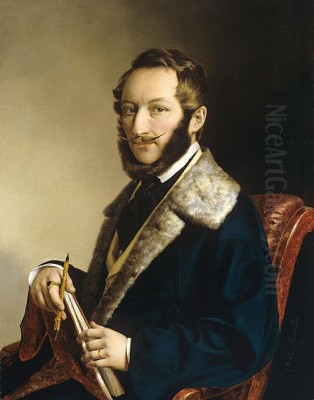
Miklós Barabás stands as a seminal figure in the landscape of 19th-century Hungarian art. Born during a period of burgeoning national consciousness and cultural revival, his life and work spanned a transformative era for Hungary. Active from the 1830s until his death in 1898, Barabás was not only a prolific painter but also a pioneer in lithography and an engaged observer of the emerging art of photography. He is best remembered for his elegant portraits that captured the likenesses of the era's leading figures, but his contributions extended to landscape, historical scenes, and genre painting, all imbued with a distinct sensibility that helped shape a Hungarian national artistic identity. His career reflects the artistic currents of his time, moving from Romantic inclinations towards a refined Realism characteristic of the Biedermeier period, while consistently maintaining a high level of technical skill and aesthetic grace.
Formative Years and Viennese Education
Miklós Barabás was born on February 10, 1810, in Kézdimárkosfalva, Transylvania, then part of the Habsburg Empire (now Mărcușa, Romania). His early artistic inclinations led him to pursue formal training. After initial studies, he made the pivotal decision to travel to Vienna, the imperial capital and a major artistic center, around 1829. There, he enrolled in the prestigious Academy of Fine Arts (Akademie der bildenden Künste Wien). During his time in Vienna, he studied under the guidance of notable artists, likely including Johan Nepomuk Ender (1793-1854), a respected Austrian painter known for his historical scenes and portraits.
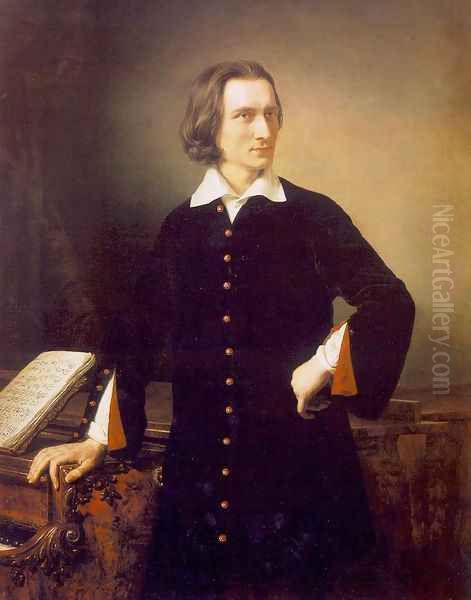
Vienna exposed Barabás to the prevailing artistic trends, particularly the Biedermeier style, which emphasized realism, domesticity, sentiment, and meticulous detail. This influence would become evident in his later work, especially his portraiture, which often combined accurate likeness with a sense of refined elegance and social propriety. Alongside his painting studies, Barabás acquired skills in another crucial medium: lithography. He learned this printing technique, relatively new and rapidly gaining popularity for its ability to reproduce images affordably, from Gábor Barra (or possibly Balassa, sources vary slightly), a fellow Hungarian artist. This technical skill would prove immensely valuable throughout his career, allowing for wider dissemination of his portraits and other works.
The Italian Journey and Artistic Maturation
Like many artists of his generation seeking to complete their education and broaden their horizons, Barabás embarked on a journey to Italy in 1834-1835. This period was crucial for his artistic development. Italy, with its rich repository of Classical and Renaissance art and its stunning landscapes bathed in Mediterranean light, offered invaluable lessons. He immersed himself in studying the works of the Old Masters and honed his skills, particularly in landscape depiction.
During his Italian sojourn, Barabás produced numerous watercolors capturing the picturesque scenery, demonstrating a growing sensitivity to light, atmosphere, and composition. This experience not only refined his technical abilities but also likely reinforced his appreciation for clarity and form. Upon returning from Italy, Barabás did not immediately settle but traveled within the Hungarian lands before establishing himself permanently in Pest (which later merged with Buda and Óbuda to form Budapest) around 1840. By this time, his reputation was growing, and Pest, as the burgeoning political and cultural heart of Hungary, provided the ideal environment for a successful artistic career.
The Celebrated Portraitist of the Reform Era
Miklós Barabás achieved his greatest fame and success as a portrait painter. He became the preferred artist for Hungary's elite during the vibrant Reform Era (roughly 1825-1848) and the subsequent decades. His sitters included prominent aristocrats, politicians, writers, musicians, and intellectuals who were shaping modern Hungary. His studio became a meeting place for the influential figures of the day, and securing a portrait by Barabás was a mark of social standing and cultural significance.
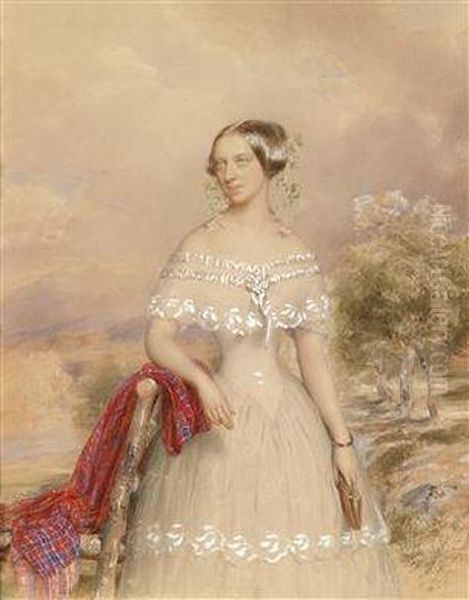
Among his most famous sitters was the renowned composer and pianist Franz Liszt (1811-1886). Barabás painted Liszt multiple times, with the 1847 portrait being particularly iconic, capturing the charismatic intensity of the Romantic virtuoso. He also immortalized key literary figures like Mihály Vörösmarty (1800-1855), János Arany (1817-1882), and the revolutionary poet Sándor Petőfi (1823-1849). His portrait of Petőfi became one of the most enduring images of the poet, widely reproduced, often through lithography. Political leaders such as István Széchenyi (1791-1860), a central figure of the Reform Era, also sat for him.
Barabás's portrait style is characterized by its elegance, technical polish, and realistic depiction. He excelled at capturing a convincing likeness while often imbuing his subjects with an air of dignity and refinement, aligning with the tastes of the Biedermeier period. His approach emphasized smooth surfaces, careful attention to detail in clothing and accessories, and balanced compositions. While sometimes criticized for lacking deep psychological penetration compared to later artists, his portraits remain invaluable historical documents and aesthetically pleasing works that perfectly encapsulate the spirit and personalities of their time. He faced competition from other skilled portraitists like József Borsos (1821-1883), but Barabás maintained preeminence for much of his career. His Portrait of a Lady exemplifies the blend of realism with elements perhaps reminiscent of earlier Baroque portraiture conventions in its rendering of textures and presence.
Chronicler of an Era: Historical and Genre Painting
While portraiture formed the bedrock of his success, Miklós Barabás also ventured into other genres, including historical scenes and depictions of everyday life, often with a nationalistic undertone. One of his most significant works in this vein is Laying the Foundation Stone of the Chain Bridge (Lánchíd alapkőletétele). This large-scale painting, worked on over several years, depicts the ceremonial event of 1842 marking the start of construction for the iconic Széchenyi Chain Bridge, the first permanent bridge connecting Buda and Pest across the Danube. The painting serves as both a historical record and a group portrait, featuring many prominent figures involved in the project, including István Széchenyi. It celebrates a key moment in Budapest's modernization and Hungary's progress.
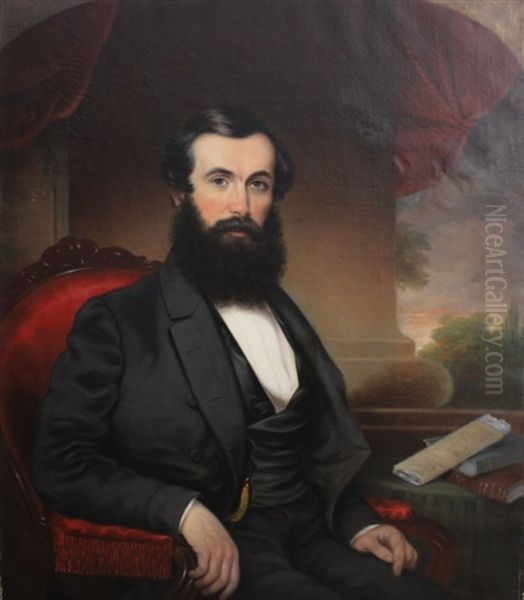
Barabás also turned his attention to genre scenes, often depicting Hungarian peasant life, folk costumes, and rural landscapes. These works resonated with the growing national consciousness and interest in folk culture during the 19th century. Paintings like Romanian Family Going to the Fair or intimate scenes like Rosty Agnes (depicting an elderly woman, possibly a relative, enjoying a moment of quiet repose) showcase his ability to capture moments of daily life with sensitivity and charm. While perhaps less dramatic than the historical canvases of contemporaries like Bertalan Székely (1835-1910) or Viktor Madarász (1830-1917), Barabás's genre works contributed significantly to the visual representation of Hungarian identity. His realistic yet often idealized depictions of rural life found favor with the urban bourgeoisie.
Mastering the Stone: Barabás and Lithography
Barabás's early training in lithography proved to be a significant asset throughout his career. He became one of the foremost practitioners of this medium in Hungary, recognizing its potential for both artistic expression and wider dissemination of images. In an era before widespread photography, lithography offered a relatively efficient way to create multiple copies of portraits, landscapes, and reproductions of paintings.
He produced numerous lithographic portraits, including those of famous contemporaries like Liszt and Petőfi, which helped solidify their public image. These prints were highly sought after. The provided text mentions an interesting detail: students sometimes commissioned lithographic portraits of their favorite professors from Barabás as keepsakes, highlighting the medium's role in academic and cultural life. His technical skill in lithography allowed him to achieve subtle tonal gradations and fine detail, making his prints highly valued. His pioneering work helped establish lithography as a respected artistic medium in Hungary, paving the way for future graphic artists. His mastery of the technique complemented his painting practice, extending his reach and influence.
Embracing New Visions: Photography, Optics, and Perspective
Intriguingly, Miklós Barabás demonstrated a keen interest in the burgeoning field of photography, which emerged during his active years. While primarily known as a painter and lithographer, he was not dismissive of the new technology but rather engaged with it. Sources suggest he explored photographic techniques and was interested in their potential, possibly even using photographs as aids for his paintings, a practice not uncommon among artists of the period seeking greater realism.
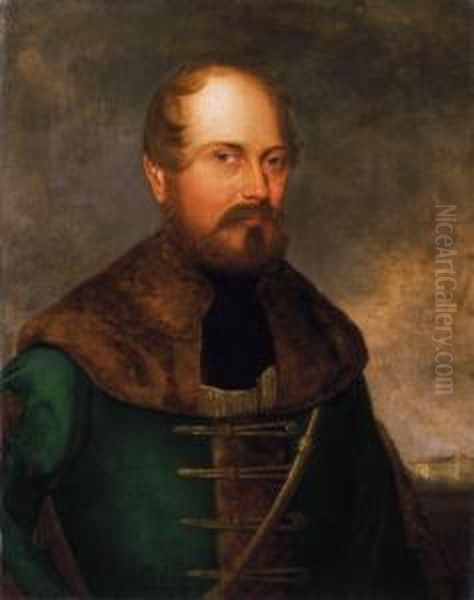
His interest extended to related scientific fields like optics and perspective. This fascination is reflected in some of his works, including panoramic sketches that attempted to capture wide vistas with attention to spatial representation. His exploration of perspective went beyond standard artistic practice, indicating a theoretical and perhaps experimental curiosity about visual perception and representation. This engagement with photography and optics places Barabás as an artist receptive to the technological and scientific advancements of his time, understanding their potential implications for visual art. While he remained committed to painting and lithography, his openness to new ways of seeing and representing the world underscores his forward-looking mindset.
Artistic Style: From Romanticism to Biedermeier Realism
Miklós Barabás's long career witnessed an evolution in his artistic style, reflecting broader European trends while retaining a personal signature. His early works show traces of Romanticism, visible perhaps in the expressive potential sought in portraits like that of the young Franz Liszt. However, his style predominantly matured into what is often described as Biedermeier Realism. This style, prevalent in Central Europe, particularly Vienna, during the first half of the 19th century, favored meticulous detail, smooth finishes, clear compositions, and often focused on depicting the lives and values of the middle class and aristocracy.
Compared to the dramatic intensity of French Romanticism, exemplified by artists like Eugène Delacroix (1798-1863), or the Neoclassical rigor of Jean-Auguste-Dominique Ingres (1780-1867), Barabás's work is characterized by its polish, clarity, and often a certain emotional restraint, even when depicting famous Romantics. His realism is grounded in careful observation and accurate rendering, particularly evident in textures of fabrics, facial features, and settings. The influence of Viennese painters like Ferdinand Georg Waldmüller (1793-1865), known for his detailed portraits and genre scenes, can be discerned. Barabás adapted these influences to a Hungarian context, creating a style that was both internationally conversant and nationally resonant, emphasizing order, representation, and technical accomplishment.
A Public Figure: Art, Society, and Institutions
Beyond his prolific artistic output, Miklós Barabás played an active role in Hungary's developing art institutions and public life. His success and reputation granted him considerable social standing. From 1862 until his death, he served as the president or director of the National Society of Hungarian Fine Arts (Országos Magyar Képzőművészeti Társulat), a key organization promoting artists and exhibitions. This position placed him at the center of the Hungarian art world for decades.
Significantly, Barabás was the first visual artist to be elected as a member of the prestigious Hungarian Academy of Sciences, a testament to his intellectual standing and the growing recognition of the arts within the nation's cultural fabric. Furthermore, his public prominence extended into the political arena when he was elected as a member of the Hungarian Parliament in 1867, the year of the Austro-Hungarian Compromise which granted Hungary greater autonomy. These roles underscore Barabás's position not just as an artist but as a respected public figure contributing to the cultural and institutional development of modern Hungary. His involvement helped elevate the status of artists and integrate the fine arts more fully into national life.
Context, Contemporaries, and Influence
To fully appreciate Miklós Barabás's contribution, it is essential to view him within the context of 19th-century Hungarian and European art. He emerged during a period when Hungarian artists were striving to establish a distinct national school. His contemporaries included landscape painter Károly Markó the Elder (1791-1860), who achieved international fame primarily working in Italy, and Károly Brocky (1807-1855), another successful portraitist who spent much of his career in London. Within Hungary, Barabás shared the artistic stage with historical painters like Soma Orlai Petrich (1822-1880), Than Mór (1828-1899), Bertalan Székely, and Viktor Madarász, who focused on depicting grand narratives from Hungarian history, often with a more overtly Romantic or patriotic fervor.
The Austrian painter August von Pettenkofen (1822-1889) also spent considerable time in Hungary, becoming known for his ethnographic genre scenes of Hungarian and Roma life, offering an external perspective that contrasts with Barabás's more integrated view. Barabás's Biedermeier-inflected realism provided a counterpoint to the more dramatic historical painting and the burgeoning plein-air landscape movement that would gain momentum later in the century. While his style might have seemed somewhat conservative compared to the revolutionary changes occurring in French art (Impressionism emerged during his later career), his work was foundational for Hungarian art. He set a high standard for technical proficiency and professional practice, influencing subsequent generations, even if they moved in different stylistic directions, such as the internationally acclaimed Mihály Munkácsy (1844-1900) or the decorative master Károly Lotz (1833-1904).
Analysis of Key Works
Several works stand out in Miklós Barabás's extensive oeuvre, encapsulating different facets of his artistry and significance.
Portrait of Franz Liszt (1847): This is arguably his most famous portrait internationally. It captures the composer at the height of his fame as a touring virtuoso. The painting balances Liszt's intense gaze and somewhat theatrical pose with Barabás's characteristic smooth finish and attention to detail, creating a powerful image of the Romantic artist.
Laying the Foundation Stone of the Chain Bridge (c. 1842-1860s): A monumental work documenting a pivotal moment in Budapest's history. It functions as a historical record, a group portrait of the era's elite, and a symbol of national progress and modernization. Its detailed realism and complex composition showcase Barabás's skill in handling large-scale subjects.
Portrait of Sándor Petőfi (various versions, including lithographs): This image became the definitive likeness of the beloved national poet and revolutionary hero. Barabás depicted Petőfi with a Romantic sensibility, capturing his youthful idealism and intensity. The wide circulation of this portrait, especially through lithography, cemented its place in the national consciousness.
Rosty Agnes (date unknown): Housed in the Hungarian National Museum (as part of the Historical Portrait Gallery, formerly Történelmi Képcsarnok), this work shows a different side of Barabás. It's an intimate portrayal of an elderly woman, rendered with realism and a quiet dignity. It demonstrates his ability to capture character and mood in less formal settings, moving towards genre painting.
These examples highlight Barabás's versatility, his technical mastery across different scales and subjects, and his crucial role in visually defining the key figures and moments of 19th-century Hungary.
Later Years and Enduring Legacy
Miklós Barabás remained an active and respected figure in the Hungarian art world well into his old age. He continued to paint and fulfill his duties at the National Society of Hungarian Fine Arts. While newer artistic styles like Impressionism and Naturalism began to emerge towards the end of his life, Barabás largely remained true to the realistic style he had perfected, which gradually came to be seen as more academic by younger generations.
He died in Budapest on February 12, 1898, just after his 88th birthday. His significant contributions were recognized with a prominent burial place in the Kerepesi Cemetery (Fiumei úti sírkert) in Budapest. His tomb is marked by a monument created by the noted sculptor Ede Telcs (1872-1948), fittingly depicting the artist with his tools, palette and brush. Posthumously, his memoirs were published, offering valuable insights into his life, travels, and perspectives on art, making him one of the first Hungarian artists to leave such a written legacy.
Miklós Barabás's legacy is multifaceted. He was a master portraitist who created an invaluable visual record of Hungary's Reform Era elite. He was a pioneer who helped establish lithography as an art form in Hungary. He was an institutional leader who contributed to the professionalization of the art world. His work, characterized by technical excellence and elegant realism, played a crucial role in shaping a Hungarian national art identity during a formative century. Though artistic tastes evolved, his paintings remain cornerstones of major Hungarian museum collections and continue to be appreciated for their historical significance and artistic merit. He laid a foundation upon which subsequent generations of Hungarian artists would build.
Conclusion
Miklós Barabás occupies an undeniable position of importance in Hungarian art history. As a painter, lithographer, and public figure, he navigated the complex cultural and political currents of the 19th century with remarkable success. His portraits provide an enduring gallery of the individuals who shaped modern Hungary, rendered with a distinctive Biedermeier elegance and realism. His technical innovations, particularly in popularizing lithography, broadened the reach of art. His leadership in artistic institutions helped foster a supportive environment for the arts. While rooted in the specific aesthetics of his time, his dedication to craft, his engagement with new technologies like photography, and his role in chronicling and contributing to the Hungarian national narrative secure his legacy. Miklós Barabás remains a foundational figure, a bridge between artistic traditions, and a key architect of Hungary's visual heritage.